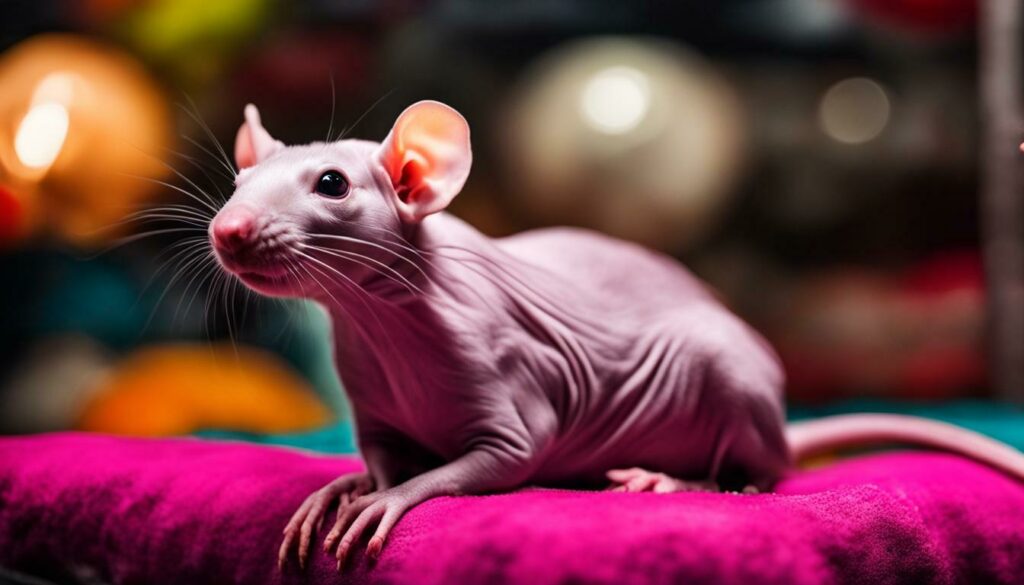Are you looking for a pet that stands out from the crowd? Look no further than a hairless rat, an unconventional and fascinating companion. These unique creatures, also known as Sphynx rats, are gaining popularity as pets for their distinctive qualities and captivating personalities.
Key Takeaways:
- Hairless rats, also known as Sphynx rats, are a relatively new breed of pets.
- They come in various colors and have large ears, long tails, and pink or gray skin.
- Hairless rats are known for their big personalities, social nature, and intelligence.
- They require a warm and comfortable environment, especially in colder climates.
- Their diet includes a mix of fresh fruits, vegetables, and high-quality rat food pellets.
- Regular veterinary check-ups are important to address common health concerns.
The Rise of Hairless Rats as Pets
Over the past few decades, hairless rats, also known as Sphynx rats, have been gaining popularity as a unique and lovable pet. These rats, which are a relatively new breed, have captivated the hearts of many rat enthusiasts with their distinct appearance and charming personalities.
When it comes to their physical characteristics, hairless rats are available in a variety of colors, including black, white, brown, and gray. They have large ears, long tails, and smooth pink or gray skin that sets them apart from their furry counterparts. Despite their lack of fur, these rats have a magnetic personality that draws people to them.
One of the reasons for the rise in popularity of hairless rats as pets is their social nature. They thrive on interaction with their human companions and enjoy being a part of the family. Hairless rats are highly intelligent and curious, making them engaging and entertaining companions. With their playful antics and inquisitive nature, they bring joy and laughter into their owners’ lives.
While hairless rats do not require any special care, providing them with a warm and comfortable environment is crucial, especially in colder climates. It is important to make sure they have access to cozy bedding and maintain a proper temperature to ensure their well-being. Additionally, their diet should consist of a mix of fresh fruits and vegetables, along with high-quality rat food pellets to meet their nutritional needs.
| Key Points: |
|---|
| – Hairless rats, also known as Sphynx rats, are becoming increasingly popular as pets. |
| – They have various colors, large ears, long tails, and pink or gray skin. |
| – Hairless rats are known for their big personalities, social nature, and intelligence. |
| – They require a warm and comfortable environment and a balanced diet. |
Just like any pet, hairless rats are susceptible to certain health issues. Common problems include respiratory infections, ear mites, and skin infections. Regular check-ups with a veterinarian are essential to ensure their well-being and address any potential health concerns.
In summary, hairless rats have risen in popularity as pets due to their unique appearance and captivating personalities. Their social nature, intelligence, and curiosity make them wonderful companions. By providing them with a cozy environment, a balanced diet, and proper healthcare, owners can foster a strong bond with their hairless rat and enjoy a fulfilling companionship for years to come.
A Look at the Appearance of Hairless Rats
Hairless rats may lack fur, but they make up for it with their striking appearance and captivating features. These unique pets come in a variety of colors, including black, white, brown, and gray. Their pink or gray skin gives them a distinct look that is sure to draw attention. With their large ears and long tails, hairless rats have a charm all their own.
“Their lack of fur allows their curious nature and intelligence to shine,” says Dr. Emily Johnson, a veterinarian specializing in small exotic pets.
“Hairless rats are incredibly fascinating creatures to observe. Their smooth skin and unique coloration make them a truly captivating addition to any rat enthusiast’s home.”
Colorful Personalities
But it’s not just their appearance that sets hairless rats apart. These little rodents are known for their big personalities. They are social animals that thrive on interaction and enjoy spending time with their human companions. Hairless rats have been described as intelligent, curious, and full of energy. They love to explore their surroundings and are often found climbing, running, and playing. Watching their antics can be both entertaining and endearing.
Caring for Hairless Rats
While hairless rats don’t require any special care, providing them with a warm and comfortable environment is essential, especially in colder climates. The temperature of their living space should be maintained at around 70-75 degrees Fahrenheit to ensure their well-being. Additionally, hairless rats require a balanced diet consisting of fresh fruits and vegetables, along with high-quality rat food pellets. Regular check-ups with a veterinarian are also important to monitor their overall health and prevent common issues like respiratory infections, ear mites, and skin infections.
| Physical Characteristics | Personality Traits | Care Tips |
|---|---|---|
| • Lack of fur | • Curious | • Provide a warm environment |
| • Pink or gray skin | • Intelligent | • Balanced diet (fruits, vegetables, and rat food pellets) |
| • Large ears | • Social | • Regular veterinary check-ups |
| • Long tail | • Energetic |
With their unique appearance, charming personalities, and relatively easy care, hairless rats make a delightful addition to any rat enthusiast’s home. Their striking features are sure to captivate and their playful nature will bring joy to their human companions. Whether you’re already a fan of rats or looking for a unique and engaging pet, hairless rats are definitely worth considering.
Unveiling the Personalities of Hairless Rats
Don’t let their lack of fur fool you – hairless rats are full of charm and personality, making them delightful companions. These unique pets are not only adorable to look at but also possess traits that make them stand out from other small animals. Hairless rats are social creatures who thrive on human interaction and form strong bonds with their owners. Their intelligence and curiosity make them quick learners, making training sessions a fun and rewarding experience for both rat and owner.
As highly social animals, hairless rats enjoy being part of a pack. They love spending time with their human companions, snuggling up for cuddles, and even grooming them. This affectionate nature and their constant need for mental stimulation make hairless rats ideal for rat enthusiasts looking for a furry friend that can offer companionship and entertainment.
Aside from their lovable nature, hairless rats are also known for their mischievous behavior. They possess an adventurous and playful spirit, always seeking out new toys and activities to keep them entertained. Interactive toys, tunnels, and exercise wheels are great options to keep hairless rats mentally stimulated and physically active. This playful nature, combined with their surprising intelligence, allows hairless rats to learn tricks and respond to commands, further enhancing the bond between rat and owner.
| Personality Traits of Hairless Rats |
|---|
| • Social and affectionate |
| • Intelligent and curious |
| • Mischievous and playful |
| • Quick learners |
To ensure their well-being, hairless rats require proper care and attention. Providing them with a warm and comfortable environment is essential, especially in colder climates. Maintaining a stable temperature and offering cozy bedding options will keep them cozy and content. Additionally, a well-balanced diet of fresh fruits and vegetables, complemented with high-quality rat food pellets, ensures their nutritional needs are met.
Regular veterinary check-ups are crucial for hairless rats, as they are prone to common health concerns such as respiratory infections, ear mites, and skin infections. Taking preventive measures and promptly addressing any health issues will ensure a long and happy life for your hairless rat.
Conclusion:
In conclusion, hairless rats are truly unique pets that captivate their owners with their charm and personality. With their social nature, intelligence, and playful disposition, they make wonderful companions for rat enthusiasts. By providing them with a warm environment, a nutritious diet, and regular veterinary care, you can enjoy a fulfilling bond and joyful playtime with your hairless rat. So, if you’re considering a small pet that stands out from the crowd, look no further than the hairless rat!
Creating the Ideal Environment for Hairless Rats
Ensuring your hairless rat feels cozy and content in its environment is crucial for its overall well-being. These unique pets thrive in a warm and comfortable space, particularly in colder climates. To provide them with the perfect habitat, here are some essential tips:
Temperature Regulation
Hairless rats have little to no fur to protect them from temperature fluctuations, so maintaining a consistent and warm environment is essential. Keep their living area between 68-74 degrees Fahrenheit (20-23 degrees Celsius) to ensure they stay comfortable. Avoid exposing them to cold drafts or sudden temperature changes, as these can cause stress or even health issues.
Bedding and Nesting Materials
Providing soft and cozy bedding is essential for hairless rats. Opt for materials such as fleece or shredded paper bedding, as these offer insulation and a comfortable sleeping surface. Additionally, consider providing nesting materials like torn tissue paper or unscented, non-toxic paper towels, allowing them to create their own cozy nests.
Cage Setup
When setting up your hairless rat’s enclosure, ensure it is spacious enough to accommodate their active nature. Provide multiple levels and platforms for climbing and exploring. Additionally, include a solid surface, such as a flat granite or ceramic tile, to help regulate their body temperature.
| Essential Supplies for Hairless Rats |
|---|
| Fleece or shredded paper bedding |
| Torn tissue paper or unscented, non-toxic paper towels |
| Multiple levels and platforms for climbing and exploring |
| Flat granite or ceramic tile |
By creating a warm, comfortable, and enriching environment, you can ensure that your hairless rat thrives and enjoys a happy and healthy life.
A Balanced Diet for Hairless Rats
Providing a well-balanced diet is key to keeping your hairless rat healthy and thriving. These unique pets have specific dietary needs that require a combination of fresh fruits and vegetables, as well as high-quality rat food pellets.
When it comes to fruits and vegetables, opt for a variety to ensure your hairless rat receives all the necessary nutrients. Some suitable options include apples, carrots, broccoli, spinach, and bell peppers. Aim to offer a mix of colors and textures to keep mealtime interesting for your pet.
| Fresh Fruits and Vegetables | Rat Food Pellets |
|---|---|
| Apples | High-quality rat food pellets |
| Carrots | Ensure the pellets are specifically formulated for rats |
| Broccoli | Check the ingredients list to ensure it contains a balanced mix of proteins, carbohydrates, and fats |
| Spinach | Offer the pellets as a staple part of your rat’s diet |
| Bell peppers | Consult your veterinarian for specific brand recommendations |
In addition to fruits and vegetables, it’s essential to provide your hairless rat with a good-quality rat food pellets. Look for pellets that are specifically formulated for rats and contain a balanced mix of proteins, carbohydrates, and fats. Offer the pellets as a staple part of your rat’s diet, and supplement with fresh produce to provide additional vitamins and minerals.
Remember to always provide fresh, clean water for your hairless rat. Regularly clean their water bottle or bowl to ensure it remains hygienic. Avoid giving your pet sugary drinks, as they can lead to potential health issues.
By following a well-balanced diet consisting of fresh fruits and vegetables, as well as high-quality rat food pellets, you can ensure your hairless rat receives the essential nutrients they need for a healthy and happy life.
Common Health Concerns for Hairless Rats
Just like any other pet, hairless rats can be prone to certain health problems, but with proper care, these can often be prevented or managed effectively. It is important for pet owners to be aware of potential health issues and take proactive steps to ensure the well-being of their hairless rats.
One common health concern for hairless rats is respiratory infections. These rats have a higher susceptibility to respiratory issues compared to their furry counterparts. Owners should ensure that the rats’ environment is clean and free from any irritants that could trigger respiratory problems. Regular ventilation, along with filtered air and dust-free bedding, can help reduce the risk of respiratory infections.
Another common issue is ear mites. These tiny parasites can cause discomfort and irritation for hairless rats. Regular ear checks and appropriate treatment can help prevent infestations. Additionally, maintaining a clean living space can reduce the risk of skin infections, which hairless rats may be prone to due to their lack of fur. Providing a warm and clean environment along with a balanced diet can support their immune system and overall health.
| Common Health Concerns | Symptoms | Prevention and Care |
|---|---|---|
| Respiratory Infections | Coughing, sneezing, difficulty breathing | Keep the environment clean and dust-free, provide proper ventilation |
| Ear Mites | Head shaking, scratching ears, dark discharge | Regular ear checks, appropriate treatment |
| Skin Infections | Redness, sores, scabs on the skin | Maintain a clean living space, provide a warm environment |
Regular veterinary check-ups are essential for hairless rats to ensure early detection of any health issues and to receive appropriate treatment. Pet owners should prioritize their rats’ well-being by providing a safe and stimulating environment, maintaining a balanced diet, and seeking professional advice when needed. With proper care, hairless rats can live happy and healthy lives as unique and cherished pets.
The Joy of Human-Animal Bonding
Building a strong bond with your hairless rat can be incredibly rewarding, creating a lasting connection that brings happiness to both of you. These unique pets are known for their social nature, and they thrive on companionship and interaction with their human caregivers.
Spending quality time with your hairless rat is essential for building a strong bond. They enjoy being held, cuddled, and even enjoy grooming sessions. By dedicating time each day to play, interact, and provide affection, you can develop a deep bond with your hairless rat.
Creating an environment of trust
Trust is a crucial component of any human-animal bond, and this holds true for hairless rats as well. Treat your rat with kindness, patience, and respect, ensuring that they feel safe and secure in their environment. Avoid sudden movements, loud noises, or anything that may startle or scare them.
Offering your hairless rat treats during training sessions is a great way to reinforce positive behavior and encourage trust. Using gentle handling techniques while avoiding any rough or forceful actions will help establish a sense of security and strengthen the bond between you and your pet.
Understanding their unique needs
As with any pet, understanding and meeting the unique needs of your hairless rat is essential for fostering a strong bond. Provide them with a warm and comfortable environment, maintaining a consistent temperature that mimics their natural habitat. Offer a balanced diet that includes fresh fruits and vegetables, along with specialized rat food pellets.
Regular veterinary check-ups are crucial for keeping your hairless rat healthy. These pets are more prone to certain health issues, such as respiratory infections and skin infections, so proactive care is necessary to avoid any complications.
| Rat Care Tips | |
|---|---|
| Provide a warm and comfortable environment | |
| Offer a balanced diet of fresh fruits, vegetables, and rat food pellets | |
| Handle your rat gently and with care | |
| Engage in daily playtime and interaction | |
| Regularly schedule veterinary check-ups | |
| Build trust through patience, kindness, and respect |
By following these rat care tips, you can ensure a healthy, happy, and meaningful relationship with your hairless rat. The joy of human-animal bonding is truly one of the most rewarding aspects of sharing your life with these unique pets.
Hairless Rats: A Pleasure to Train
Hairless rats are not only smart and inquisitive but also eager to please, making them a joy to train and interact with. These remarkable rodents possess a natural curiosity that drives their desire to explore and learn. They are quick learners and can easily pick up tricks and commands, making them terrific candidates for training.
To successfully train a hairless rat, it is important to create a positive and stimulating environment. Use positive reinforcement techniques such as treats and praise to reward desired behaviors. Consistency and patience are key, as these intelligent creatures thrive on routine and repetition.
When training hairless rats, it is crucial to remember that they are social animals and enjoy the company of their human counterparts. Take the time to bond with your pet rat during training sessions, as this will strengthen your relationship and reinforce trust. Engage in interactive play and provide plenty of mental stimulation to keep their curious minds engaged.
Incorporating interactive toys and activities into your training routine can add an element of fun and excitement for both you and your hairless rat. Stimulating toys, such as puzzle feeders, can keep their minds sharp and provide necessary enrichment. Remember to vary the training sessions to avoid repetition and keep your pet rat engaged.
| Training Tips for Hairless Rats |
|---|
| 1. Start with basic commands such as “sit” and “stay” before moving on to more advanced tricks. |
| 2. Use small, bite-sized treats as rewards during training sessions. |
| 3. Keep training sessions short and frequent, as hairless rats have shorter attention spans. |
| 4. Use a clicker to reinforce positive behaviors and signal when a reward is coming. |
| 5. Never use punishment or force during training, as this can damage the trust and bond between you and your rat. |
Training your hairless rat can be an immensely rewarding experience. The bond formed through training and interaction will not only provide entertainment and mental stimulation for your pet but also enhance your own enjoyment as a rat owner. So, grab some treats, get ready to have fun, and watch as your hairless rat showcases their incredible intelligence and personalities.
The Joy of Playtime with Hairless Rats
Engaging in playtime activities with your hairless rat provides not only physical stimulation but also strengthens the bond between you and your furry companion. These spirited rodents love to explore and interact with their environment, making playtime an essential part of their daily routine.
One way to keep your hairless rat entertained is by providing them with interactive toys. These can range from simple items such as cardboard tubes and tunnels to more complex puzzle toys that challenge their problem-solving skills. Watching your rat navigate these toys with their agile bodies and inquisitive nature is both fascinating and entertaining.
Another activity that hairless rats enjoy is interactive play with their human companions. You can use a feather, string, or a small ball to engage them in a game of chase, encouraging them to climb, jump, and pounce. This not only helps them burn off excess energy but also builds trust and strengthens the bond between you and your pet.
| Benefits of playtime with hairless rats: |
|---|
| 1. Provides mental stimulation and helps prevent boredom. |
| 2. Promotes physical exercise and helps maintain a healthy weight. |
| 3. Increases socialization and builds trust between you and your pet. |
| 4. Reduces stress and anxiety in hairless rats. |
Remember to always supervise playtime and ensure the toys and play area are safe for your hairless rat. Avoid small objects that they can swallow, and provide a secure, rat-proof space to prevent any accidents. By dedicating regular play sessions with your hairless rat, you can provide them with both physical and mental stimulation while enjoying the unique bond that comes with these charming rodents.
Hairless Rats: The Perfect Pet for Rat Enthusiasts
If you’re captivated by the charm of rats and seeking an extraordinary furry friend, a hairless rat may be the perfect pet for you. Also known as Sphynx rats, these unique creatures are gaining popularity as small pets and have a lot to offer to their owners. With their distinctive appearance and big personalities, hairless rats bring a new level of fascination to the world of rat enthusiasts.
These hairless rodents are a relatively new breed, with the first one being born in the early 1990s. They come in various colors, including black, white, brown, and gray, making them quite striking to look at. Their large ears, long tails, and pink or gray skin add to their distinctive appearance. But it’s their personalities that truly set them apart.
Hairless rats are social animals that thrive on companionship and enjoy spending time with their human owners. They are intelligent, curious, and highly engaging, always seeking interaction and mental stimulation. Whether it’s playing games, learning tricks, or simply snuggling up for some quality time, hairless rats make for incredibly entertaining and affectionate pets.
| Benefits of Owning a Hairless Rat |
|---|
| 1. Unique and striking appearance |
| 2. Big personalities and social nature |
| 3. Intelligent and curious, making them easy to train |
| 4. Bond deeply with their human companions |
| 5. Enjoy interactive playtime and mental stimulation |
While hairless rats don’t require any special care, it’s important to create a warm and comfortable environment for them, especially in colder climates. Providing them with cozy bedding, ensuring proper temperature regulation, and keeping their living space clean will ensure their well-being and happiness. Their diet should consist of a mix of fresh fruits and vegetables, along with high-quality rat food pellets to meet their nutritional needs.
Like any pet, hairless rats are prone to certain health issues, such as respiratory infections, ear mites, and skin infections. To keep them in optimal health, regular check-ups with a veterinarian should be a priority. With proper care and attention, these extraordinary pets can bring endless joy and companionship to rat enthusiasts, making them a truly unique addition to any household.
Caring for Your Hairless Rat: A Summary
Caring for a hairless rat requires attention to a few essential aspects, ensuring their health and happiness for a lifetime of companionship. These unique pets have distinctive needs that should be met to ensure their well-being.
Creating a warm and comfortable environment for your hairless rat is crucial, especially in colder climates. Providing a cozy cage with bedding and ensuring proper temperature regulation will help them thrive. Additionally, offering a balanced diet is essential. Hairless rats should be fed a combination of fresh fruits and vegetables, as well as high-quality rat food pellets to ensure they receive all the necessary nutrients.
Regular veterinary check-ups are vital to monitor your hairless rat’s health. They are prone to certain health issues such as respiratory infections, ear mites, and skin infections. Prompt medical attention can prevent these conditions from worsening and keep your pet happy and healthy.
Finally, nurturing the human-animal bond is key to ensure the happiness of your hairless rat. These small rodents are intelligent and enjoy interactive playtime with their human companions. Engaging in training sessions and providing stimulating toys and activities will keep them mentally engaged and entertained.
| Key Aspects of Hairless Rat Care | Summary |
|---|---|
| Environment | Create a warm and comfortable cage with proper temperature regulation. |
| Diet | Provide a balanced diet consisting of fresh fruits, vegetables, and high-quality rat food pellets. |
| Healthcare | Schedule regular veterinary check-ups to monitor and address any health concerns. |
| Bonding | Engage in interactive playtime, training sessions, and provide stimulating toys and activities for mental stimulation. |
Conclusion
In conclusion, hairless rats are not your typical pet, but they offer a world of charm, personality, and love to those who open their hearts to these captivating creatures. As a relatively new breed, hairless rats have steadily gained popularity as small pets, thanks to their unique physical appearance and distinctive traits.
With their bald skin and various color options, hairless rats are eye-catching and fascinating to observe. Their large ears and long tails only add to their charm. But it’s their big personalities that truly make them stand out. Hairless rats are social animals that enjoy human interaction, and they quickly form strong bonds with their human companions. Their intelligence, curiosity, and playfulness make them engaging and entertaining pets.
While hairless rats don’t require any special care, it’s important to provide them with a warm and comfortable environment, especially in colder climates. They thrive in a temperature-regulated space, ensuring their well-being and happiness. Additionally, a balanced diet that includes a mix of fresh fruits and vegetables, along with high-quality rat food pellets, is essential to maintain their health.
Regular veterinary check-ups are crucial for hairless rats, as they are susceptible to common health issues such as respiratory infections, ear mites, and skin infections. By taking proactive steps and seeking professional advice, owners can ensure the well-being of their hairless rat and enjoy many happy, healthy years together.
FAQ
Are hairless rats the same as Sphynx rats?
Yes, hairless rats are also known as Sphynx rats. They are both terms used to describe the same breed of rats.
What colors do hairless rats come in?
Hairless rats are available in various colors, including black, white, brown, and gray.
What are the physical characteristics of hairless rats?
Hairless rats typically have large ears, long tails, and pink or gray skin due to their lack of fur.
What is the personality of a hairless rat like?
Hairless rats have big personalities. They are social animals, intelligent, and curious, making them engaging and entertaining pets.
How should I create the ideal environment for my hairless rat?
It is important to provide a warm and comfortable environment for hairless rats, especially in colder climates. Proper temperature regulation is crucial.
What should I feed my hairless rat?
Hairless rats require a balanced diet consisting of a mix of fresh fruits and vegetables, as well as high-quality rat food pellets.
What are the common health concerns for hairless rats?
Hairless rats are susceptible to respiratory infections, ear mites, and skin infections. Regular veterinary check-ups are recommended to ensure their health.
Can hairless rats form a strong bond with their human companions?
Yes, hairless rats can form a unique and strong bond with their human companions. Spending time together can bring mutual affection and joy.
Are hairless rats trainable?
Yes, hairless rats are intelligent and curious, making them trainable. They can learn tricks and respond to commands.
How can I keep my hairless rat entertained and stimulated?
Playtime is important for hairless rats. Interactive toys and activities can keep them entertained, stimulated, and mentally engaged.
Are hairless rats suitable for rat enthusiasts?
Absolutely! Hairless rats are a perfect choice for rat enthusiasts who appreciate their unique qualities and the fulfillment they bring as pets.
What is the summary of caring for a hairless rat?
Caring for a hairless rat includes creating a comfortable environment, providing a balanced diet, addressing health concerns, and nurturing the human-animal bond.







